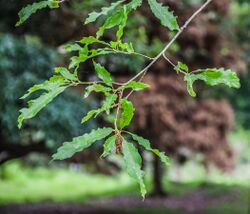Biology:Quercus lancifolia
| Quercus lancifolia | |
|---|---|

| |
| Scientific classification | |
| Kingdom: | Plantae |
| Clade: | Tracheophytes |
| Clade: | Angiosperms |
| Clade: | Eudicots |
| Clade: | Rosids |
| Order: | Fagales |
| Family: | Fagaceae |
| Genus: | Quercus |
| Subgenus: | Quercus subg. Quercus |
| Section: | Quercus sect. Quercus |
| Species: | Q. lancifolia
|
| Binomial name | |
| Quercus lancifolia Schltdl. & Cham.
| |
| Synonyms[2] | |
| |
Quercus lancifolia is a species of oak found in Central America and Mexico.[3][4]
Description
Quercus lancifolia is a large forest tree up to 30 metres (98 feet) tall with a trunk 100 centimetres (39 inches) or more in diameter. The leaves are up to 22 cm (8 5⁄8 in) long, sometimes with no lobes or teeth but sometimes with undulations or sharp teeth; they are green on top, and both whitish and waxy on the underside.[4]
Habitat and range
Quercus lancifolia inhabits montane cloud forests between 500 and 2,400 meters elevation. It can be a dominant species where it occurs.[1]
In Mexico it is found in the southern Sierra Madre Oriental of Hidalgo, Veracruz, and Puebla states, the Sierra Madre de Oaxaca in Puebla and Oaxaca states, the Chiapas Highlands, and the Sierra Madre de Chiapas of Chiapas and adjacent Guatemala. In Central America it inhabits the Maya Mountains of Belize and the highlands of Guatemala, Honduras, Nicaragua, Costa Rica, and western Panama.[1]
Conservation and threats
Quercus lancifolia is affected by habitat loss and habitat fragmentation across most of its range. Of Mexico's original 3.1 million ha of cloud forest, only 28% remained by 2002, and half of what remained was degraded or secondary forest. In Veracruz only 10% of the original cloud forest area remains.[1]
Although the population has not been quantitatively assessed, there are no reports of continued decline. The species' conservation status is assessed as Least Concern.[1]
References
| Wikimedia Commons has media related to Quercus lancifolia. |
- ↑ 1.0 1.1 1.2 1.3 1.4 Jerome, D. 2018. Quercus lancifolia. The IUCN Red List of Threatened Species 2018: e.T194185A2303351. https://dx.doi.org/10.2305/IUCN.UK.2018-2.RLTS.T194185A2303351.en. Accessed 19 August 2022.
- ↑ Quercus lancifolia Schltdl. & Cham. Plants of the World Online, Kew Science. Accessed 26 February 2023.
- ↑ "Quercus lancifolia Schltdl. & Cham. — The Plant List". http://www.theplantlist.org/tpl1.1/record/kew-173502.
- ↑ 4.0 4.1 McVaugh, R. 1974. Flora Novo-Galiciana: Fagaceae. Contributions from the University of Michigan Herbarium 12:39-40 in English with line drawing on page 39
Wikidata ☰ Q15338342 entry
 |


